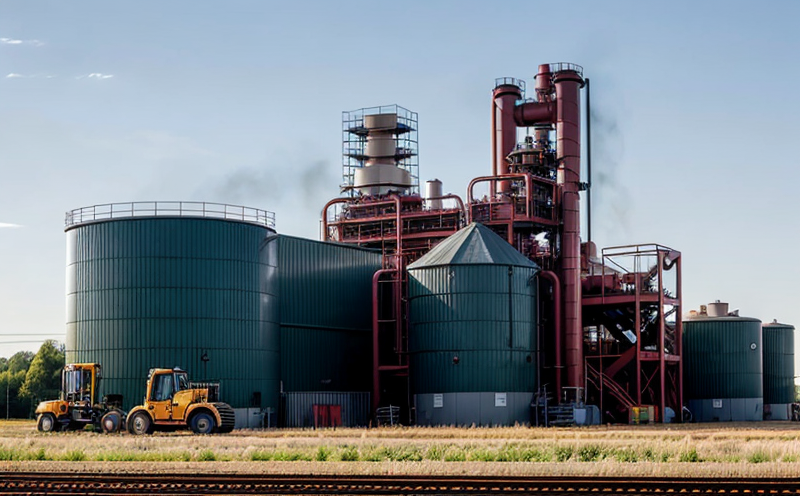ISO 3747 Stone Crusher Noise Testing
The ISO 3747 standard is specifically designed to provide guidelines for measuring and assessing noise emissions from machinery and industrial equipment, including stone crushers. This service ensures that the noise levels generated by these machines meet stringent international standards, which are crucial for both compliance with regulatory requirements and protection of human health.
Stone crushers play a vital role in industries such as construction, mining, and aggregate production. However, their high decibel levels can pose significant risks to workers' hearing health if not controlled properly. By conducting ISO 3747 noise testing, we ensure that these machines do not exceed permissible noise limits set by international standards.
Our team of experts uses advanced acoustic measurement equipment and follows precise procedures outlined in the ISO 3747 standard to conduct comprehensive noise assessments on stone crushers. This includes measuring sound pressure levels at various distances from the machine and under different operating conditions. The goal is to provide accurate, reliable data that can be used for compliance purposes or as part of an ongoing improvement process.
One of the key aspects of this service is ensuring proper specimen preparation before testing begins. This involves setting up the stone crusher in a controlled environment where it can operate under normal working conditions. Once prepared, the machine is allowed to run at different speeds and loads to simulate real-world usage scenarios. This approach helps us gather more accurate data on how noise levels vary depending on operational parameters.
The testing process itself involves placing microphones around the stone crusher to capture sound waves emitted in all directions. We then use specialized software to analyze this data and calculate compliance with the specified limits established by ISO 3747. Our team also provides detailed reports that outline our findings, including any areas where improvements could be made to reduce noise emissions.
In addition to meeting regulatory requirements, conducting ISO 3747 noise testing offers several benefits for stakeholders involved in the design and operation of stone crushers. For quality managers, it provides valuable insights into potential issues that need addressing during the manufacturing process. Compliance officers can use this information to ensure ongoing adherence to applicable laws and regulations. R&D engineers may find useful data that informs future designs aimed at reducing noise levels without compromising performance.
For procurement teams, knowing which suppliers adhere to such stringent standards demonstrates a commitment to worker safety and environmental responsibility. Ultimately, by adhering to ISO 3747 guidelines for stone crusher noise testing, organizations demonstrate their dedication not only to meeting legal obligations but also enhancing overall workplace safety practices.
Why It Matters
Noise exposure is a serious occupational hazard that can lead to hearing loss if proper precautions aren't taken. In the context of stone crushers, which often operate in environments already characterized by loud noises from other machinery, excessive noise levels could exacerbate this risk further. Therefore, ensuring compliance with ISO 3747 standards isn't just about meeting legal requirements; it's also about safeguarding worker health and wellbeing.
The standard provides clear metrics for what constitutes acceptable noise exposure levels based on the duration of time workers are exposed to certain decibel ranges. By adhering to these limits, companies can help prevent long-term damage to employees' hearing while maintaining productive operations. Furthermore, demonstrating adherence to such internationally recognized standards enhances an organization's reputation as a responsible corporate citizen.
From an operational perspective, understanding noise levels generated by stone crushers allows operators to make informed decisions about maintenance schedules and potential upgrades that could reduce noise emissions without sacrificing production efficiency. This knowledge also supports efforts towards sustainable practices within the industry, contributing positively to broader environmental goals.
International Acceptance and Recognition
The ISO 3747 standard has gained widespread acceptance across many countries due to its comprehensive approach to measuring noise emissions from machinery. Its adoption reflects a global consensus on the importance of controlling noise pollution in industrial settings, particularly those involving heavy equipment like stone crushers.
Many nations have incorporated provisions related to ISO 3747 into their national laws and regulations regarding occupational safety and health. Compliance with these standards not only ensures that local workers are protected but also facilitates smoother international trade by aligning practices globally. For companies operating across borders, meeting internationally recognized standards like ISO 3747 can simplify compliance efforts and reduce the risk of non-compliance penalties in multiple jurisdictions.
The standard’s broad applicability extends beyond just stone crushers to other types of machinery used in various industries. This versatility underscores its value as a tool for promoting safer working conditions worldwide. By embracing this standard, businesses contribute towards creating healthier work environments and fostering greater trust among stakeholders who rely on them for responsible corporate behavior.
Environmental and Sustainability Contributions
Beyond immediate benefits to worker health, adhering to ISO 3747 standards can have broader environmental impacts. Noise pollution from industrial equipment like stone crushers can disrupt ecosystems and affect wildlife in nearby areas. By reducing noise emissions through rigorous testing and subsequent adjustments based on ISO 3747 guidelines, businesses contribute positively to preserving natural habitats.
Additionally, quieter operations lead to more efficient use of resources since less energy may be required for cooling systems or other auxiliary equipment designed to mitigate excessive heat generated by loud machinery. This reduction in resource consumption aligns with broader sustainability goals within the industry and beyond. Companies that embrace such practices position themselves favorably regarding public perception and potentially attract customers who prioritize eco-friendly products and services.
Furthermore, adopting ISO 3747 standards demonstrates a company's commitment to long-term sustainability initiatives. As society continues to focus on reducing its carbon footprint, industries must adapt by integrating greener practices into their operations. By addressing noise pollution as part of these broader efforts, businesses not only contribute directly but also set an example for others within the sector.





